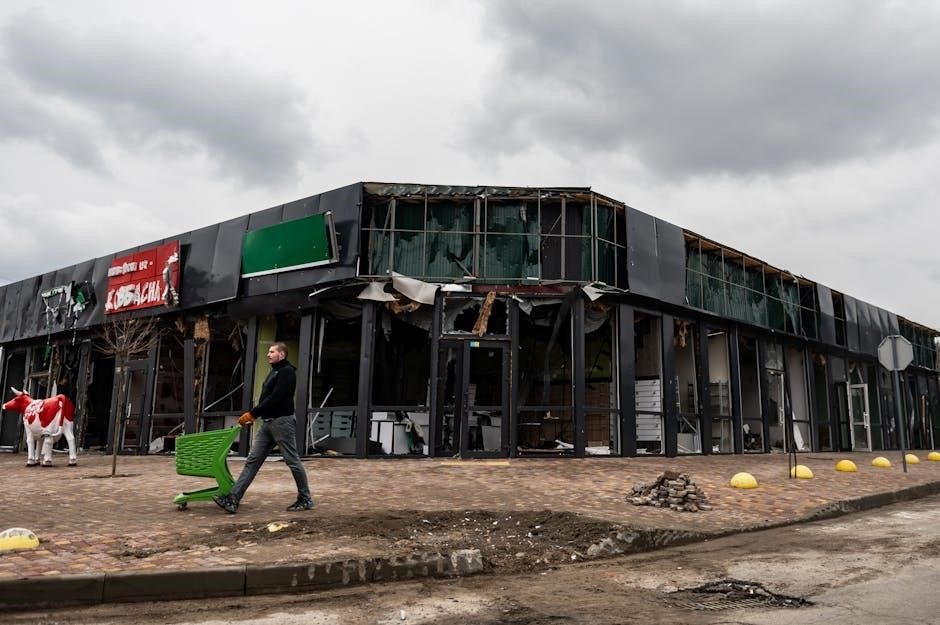A Disaster Recovery Plan (DRP) is a documented strategy outlining procedures to quickly recover IT infrastructure and minimize business interruptions during disasters. Available as PDF templates, it ensures business continuity and data protection critically.

Overview of Disaster Recovery Planning
Disaster recovery planning is a comprehensive process to ensure business continuity by restoring IT infrastructure and operations after disruptions. It involves creating detailed strategies to minimize downtime, data loss, and financial impact. A well-structured DRP outlines procedures for assessing risks, identifying critical systems, and implementing backup and recovery solutions. The plan also establishes recovery time objectives (RTOs) and recovery point objectives (RPOs) to guide restoration efforts. Available as customizable PDF templates, DRPs provide a standardized framework for organizations to prepare for and respond to disasters effectively, ensuring operational resilience and maintaining stakeholder confidence.
Importance of a Disaster Recovery Plan
A Disaster Recovery Plan (DRP) is essential for ensuring business continuity and resilience in the face of disruptions. It minimizes downtime, financial losses, and reputational damage by providing a clear roadmap for recovery. A DRP helps organizations restore critical systems and data promptly, ensuring operational stability. It also safeguards customer trust by maintaining service availability. Without a DRP, businesses risk prolonged outages, data loss, and potential closure. A well-structured DRP not only protects IT infrastructure but also aligns with regulatory requirements, making it a critical asset for modern organizations aiming to thrive in uncertain environments.

Key Components of a Disaster Recovery Plan
A DRP includes risk assessment, roles and responsibilities, backup strategies, and recovery procedures. It ensures alignment with business objectives to minimize disruptions and data loss effectively.
Risk Assessment and Business Impact Analysis
Risk assessment identifies potential threats and vulnerabilities, while business impact analysis evaluates the effects of disruptions on operations. This step ensures critical systems are prioritized, and recovery objectives align with business needs. By understanding the likelihood and impact of disasters, organizations can develop targeted strategies to mitigate risks. Regular updates to this analysis ensure the plan remains relevant as the business environment evolves. This foundational step guarantees that recovery efforts focus on minimizing downtime and data loss, ultimately protecting the organization’s continuity and reputation. Accurate assessment and analysis are vital for creating an effective DRP.
Roles and Responsibilities
Defining clear roles and responsibilities is essential for effective disaster recovery. The disaster recovery team should include key personnel with specific tasks, ensuring no single point of failure. Roles may include IT staff, management, and external vendors. Each member’s responsibilities should be documented in the DRP, including communication protocols and decision-making authority. Regular training and updates ensure everyone understands their duties. This clear structure minimizes confusion during crises and ensures swift action. Cross-training team members for critical tasks guarantees redundancy, while accountability measures maintain focus on recovery objectives. Properly defined roles and responsibilities are fundamental to the plan’s success and efficiency.
Backup and Recovery Strategies
Effective backup and recovery strategies are central to a Disaster Recovery Plan (DRP). Regular data backups, stored both onsite and offsite, ensure redundancy and quick access during crises. Cloud-based solutions offer additional layers of protection, allowing data restoration from multiple locations. Automated backup systems minimize human error and ensure consistency. Recovery strategies should align with Recovery Time Objectives (RTO) and Recovery Point Objectives (RPO), prioritizing critical systems. Testing backups regularly is crucial to verify data integrity and recovery processes. A well-planned strategy ensures minimal data loss and rapid system restoration, safeguarding business operations and continuity. Proper documentation of backup schedules and storage locations is also essential.
Steps to Create a Disaster Recovery Plan
Identify critical systems, define recovery objectives, assign roles, and document backup strategies. Regular testing and updates ensure the plan remains effective and aligned with business needs.
Identify Critical Systems and Processes
Identifying critical systems and processes is the cornerstone of a robust Disaster Recovery Plan (DRP). This step involves evaluating which IT infrastructure, applications, and data are essential for maintaining business operations. By pinpointing these elements, organizations can prioritize recovery efforts, ensuring minimal disruption during a disaster. For instance, PDF templates often include sections for listing critical systems, such as servers, databases, and communication networks. Additionally, processes like payroll operations or customer service workflows are documented to ensure continuity. This identification phase lays the foundation for effective recovery strategies, aligning with the objectives outlined in the DRP.
Develop Recovery Objectives (RTO and RPO)
Recovery Time Objective (RTO) and Recovery Point Objective (RPO) are critical metrics in a Disaster Recovery Plan (DRP). RTO defines the maximum time an organization can tolerate a system outage before recovery, while RPO specifies the maximum data loss acceptable. These objectives ensure alignment with business continuity goals. For example, an RTO of 4 hours means systems must be restored within that timeframe, while an RPO of 1 hour ensures no more than an hour of data is lost. These metrics guide backup and recovery strategies, minimizing downtime and data loss. PDF templates often include sections for documenting these objectives, ensuring clarity and accountability during recovery operations.
Create a Disaster Recovery Team
Creating a Disaster Recovery Team (DRT) is essential for effective disaster recovery. This team includes representatives from IT, HR, finance, and communications, ensuring diverse expertise. Each member has defined roles, such as incident management, data restoration, and stakeholder communication. The team must maintain updated contact information and meet regularly for training. Regular drills and updates ensure preparedness. The DRT’s primary goal is to coordinate recovery efforts efficiently, minimizing downtime and data loss. PDF templates often include sections for team rosters, roles, and emergency contact details, ensuring clarity during crises. A well-structured DRT is vital for swift and effective recovery operations.
Best Practices for Implementing a DRP
Adopt regular testing of your DRP, ensure clear communication and training, and maintain accessible documentation. Consider a multi-cloud strategy for enhanced data security and availability.
Regular Testing and Updates
Regular testing and updates are critical to ensure the DRP remains effective. Conduct simulations and drills to identify weaknesses and validate recovery processes. Review and update the plan annually or after significant infrastructure changes. Incorporate feedback from team members and stakeholders to refine strategies. Use multi-cloud backup solutions to enhance data redundancy and accessibility. Ensure all recovery objectives align with current business needs. Document test results and implement necessary improvements promptly. This proactive approach minimizes downtime and ensures seamless recovery during actual disasters, safeguarding business continuity and data integrity. Regular updates also keep the plan relevant and adaptable to evolving threats.
Communication and Training
Effective communication and training are essential for a successful DRP. Ensure all team members understand their roles and responsibilities through regular workshops and drills. Provide clear communication channels during a disaster to maintain coordination and minimize confusion. Train employees on the latest recovery tools and procedures to enhance preparedness. Use customizable templates to create concise guides for easy reference. Regular updates and simulations ensure the team is well-prepared to respond swiftly and efficiently. Proper training also fosters confidence, enabling seamless execution of recovery strategies during critical situations. This ensures business continuity and minimizes the impact of disruptions.
Documentation and Accessibility
Thorough documentation is critical for an effective DRP. Ensure the plan is well-organized and easily accessible to all stakeholders. Store copies in multiple formats, including PDF, for quick reference during emergencies. Regularly update the document to reflect changes in infrastructure or processes. Use standardized templates to maintain consistency and clarity. Accessibility is key—store physical copies offsite and digital versions in secure cloud storage. This ensures that critical information is available when needed, enabling swift recovery and minimizing downtime. Proper documentation also aids in compliance with industry standards and facilitates smooth audits.

Disaster Recovery Plan Templates
Disaster recovery plan templates, including PDF formats, provide structured frameworks for creating customized DRPs. They ensure consistency and adaptability across different industries and organizational needs effectively.
PDF Templates for DRP
PDF templates for Disaster Recovery Plans (DRP) offer a structured, customizable framework to outline recovery strategies. These templates are widely available, often for free, and provide pre-designed sections for critical information such as contact details, recovery steps, and emergency protocols. Many PDF templates are tailored for specific industries, ensuring relevance and adaptability. They are static, fully indexed, and easily accessible, making them ideal for organizations seeking a clear, professional approach to disaster recovery planning. Using a PDF template ensures consistency and helps minimize decision-making during crises, allowing teams to focus on swift recovery and business continuity.
Customizable Templates for Different Industries
Customizable Disaster Recovery Plan (DRP) templates cater to specific industries, addressing unique challenges and regulatory requirements. For instance, healthcare organizations may focus on HIPAA compliance, while financial institutions prioritize data security. These templates are designed to be adaptable, ensuring that critical operations can resume swiftly. They often include industry-specific recovery steps, contact lists, and emergency protocols. By tailoring templates to meet sector-specific needs, businesses can ensure a more effective and relevant disaster recovery strategy. This customization enhances preparedness and minimizes downtime, making it easier to restore operations during crises while maintaining industry standards and compliance.
Case Studies and Examples
Real-world case studies demonstrate the effectiveness of Disaster Recovery Plans. Examples include the 2014 payroll disaster recovery, showcasing strategies to restore operations swiftly and minimize data loss.
Successful DRP Implementations
Many organizations have successfully implemented DRPs, ensuring minimal downtime and data loss during crises. A notable example is a company that used a PDF DRP template to restore payroll operations swiftly after a system failure. By leveraging predefined recovery strategies, they maintained business continuity and customer trust. Another case involved a financial institution that utilized a customizable DRP to recover critical systems within their RTO. These examples highlight how well-structured DRPs, available in formats like Word and PDF, empower businesses to respond effectively to disasters, ensuring operational resilience and minimizing financial impact.
Lessons Learned from Real-World Disasters

Real-world disasters have underscored the importance of robust DRPs. A financial institution, for instance, recovered swiftly from a data center outage by leveraging its pre-defined recovery strategies. Similarly, a healthcare system learned the value of regular testing after a ransomware attack exposed gaps in their backup processes. These cases highlight the need for clear communication, cross-training teams, and maintaining updated recovery documentation. Organizations that adopt customizable DRP templates, such as those in PDF format, often fare better, as they can adapt strategies to their unique needs, ensuring business continuity during crises.



